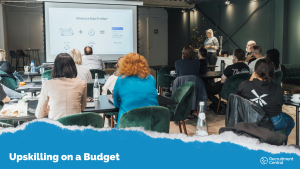Wondering how to reduce time to hire or calculate the real cost of vacancy in your business? This guide explains why hiring processes are slowing down, what those delays really cost, and how to fix them. Discover practical steps to streamline recruitment, protect your employer brand, and make faster, smarter hiring decisions that save time and money.
Hiring has become more complex, and many teams feel it every day. A process that once took weeks can now stretch into months. The average time to hire has increased across most industries. In some fields, it’s normal for roles to stay open for 60, 70, or even 90 days.
If your team has felt that frustration lately, you’re not alone.
Several factors are driving this change.
Volume is one. Technology makes it easy for people to apply for several jobs at once. Candidates can explore opportunities fast, but it also means hiring managers spend a lot more time sorting through applications.
Screening systems and AI can help filter through candidates faster, but studies show that automation can sometimes remove great people accidentally, and most teams can’t afford to rely entirely on it.
Expectations have changed, too. Companies want proof of skills, not just CVs or resumes. As the most important skills for key roles evolve, businesses are becoming more cautious about identifying the right employees. Many now use extra interviews, assessments, and tests to better understand applicants’ capabilities.
That caution makes sense. A bad hire is expensive, but long delays have their own cost. Vacancies pile up, and each one takes longer to fill. Over time, this backlog drains energy and focus.
Remote and hybrid work strategies can also add more hurdles. With teams across time zones, scheduling interviews takes longer, and decision-makers have less time. Recruitment often slows not because no one cares, but because no one owns the timeline.
These problems create a slow, uncertain process, and candidates notice. Nearly 60% say they’ve had a poor hiring experience, and about 72% share that story with others. This makes it even harder to attract the right people in the future.
Understanding the True Cost of Vacancies
Hiring delays do more than frustrate teams. They drain resources and funds faster than many companies realise. It’s not just about spending more on job ads or recruitment services, extended vacancies can quietly erode a business’s value over time.
Direct Financial Costs
Some expenses are visible straight away. Job boards, recruitment fees, and background checks all cost money. However, one of the biggest direct costs is lost output. When a role stays empty, the work doesn’t disappear. It stops moving forward, or other employees have to cover the gaps.
According to a 2024 Australian Bureau of Statistics report, unfilled positions have risen by more than 70% since 2020, with thousands of businesses reporting project delays and lower productivity as a direct result of longer hiring cycles. This shows how much value is lost when roles stay open for too long.
That figure doesn’t include the time hiring managers spend screening candidates, arranging interviews, and following up. It also doesn’t reflect the extra cost of restarting the process when a candidate withdraws or drops out because the hiring process takes too long.
Revenue Impact
Losses are more visible when the unfilled role contributes directly to sales or revenue. Missing salespeople mean fewer deals closed, and an empty managerial role leaves teams without direction. Projects often get delayed even when others step in to help.
This can damage client relationships over time. Overworked employees are more likely to make mistakes, and customers lose confidence. These issues don’t just affect this quarter’s results, they can weaken your competitive position in the long term.
Indirect and Hidden Costs
Other costs are harder to measure but just as damaging. When roles remain open, other employees step in to help. At first, teams cope. Over time, that effort takes a toll. People work longer hours, split focus, and eventually burn out.
Organisations without strong backup or succession plans struggle to move internal talent fast enough to fill the gaps. This strain affects morale and trust in leadership. Over time, vacancies start to feel like the norm, with no plan to fix them.
Employer Brand and Candidate Experience
Vacancies are never invisible. Candidates notice delays. They wait weeks for updates or see job postings with no movement. This experience shapes how they view your company, especially when they share their stories on review sites and social media.
Over time, this weakens your employer brand, making it harder to attract quality candidates. Even people who don’t take the job may still share how they were treated, and those stories can shape how others see your company for years to come.
Rising Compensation Pressure
When the process drags on, the pressure to close the deal grows. Hiring managers may raise offers or add extra benefits to speed things up.
In tight job markets, this can mean thousands in extra pay to secure a candidate. If existing staff notice new hires getting higher salaries, they may also push to renegotiate their own pay.
Calculating Cost of Vacancy (COV): A Practical Framework
Many leaders sense that unfilled roles are expensive, but few calculate the exact numbers. Measuring vacancy costs gives you clarity and helps with better decisions.
The good news is you don’t need a complicated model. A simple framework can help you understand what each day of delay really costs.
Knowing your cost of vacancy helps you:
- Compare vacancy costs against your hiring investments.
- Explain to stakeholders why timelines matter.
- Identify which roles are critical and need faster action.
| Step | Description |
|---|---|
| Step 1: Estimate the Role’s Annual Value | Estimate how much value a role delivers based on revenue, productivity, or cost savings. A good rule of thumb is that an employee’s value is 1 to 3 times their annual salary. For example, someone earning $60,000 might contribute around $180,000 in annual value. |
| Step 2: Break Down the Daily Impact | Divide the annual value by 260 working days to find the daily cost. Example: $120,000 ÷ 260 = $461 per day. This shows the daily loss when work isn’t being completed. |
| Step 3: Add Direct Recruitment Expenses | Include costs such as job advertisements, recruiter fees, interviews, and background checks. Research suggests these can total 12–30% of the role’s annual salary. |
| Step 4: Factor in Opportunity Costs | Identify what business opportunities are lost while the role remains vacant, such as delayed projects, lost clients, or missed revenue. |
| Step 5: Consider Indirect Costs | Include the effects of burnout, lower morale, and damage to your employer brand. These may not show immediately but impact performance long term. |
Using the Numbers
Once you have your estimates, you can:
- Prioritise which roles to fill faster.
- Justify investment in external recruitment support or better tools.
- Set clear timelines and budgets.
You’ll also gain a more realistic view of how much value your recruitment strategy delivers.
The Ripple Effects: Beyond Financial Impact
Extended vacancies cost your business more than money. They create stress across teams, hurt your reputation, and slow your growth.
Employee Burnout and Morale
When a role remains unfilled, the extra work has to go somewhere. At first, teams step up because they care about each other and don’t want to let standards slip. But over time, the load becomes too heavy. Tasks pile up, and small frustrations grow. Employees who were once engaged start to feel stretched and resentful.
Research shows that overwork leads to burnout and turnover. Even when employees stay, their engagement and accuracy drop.
Customer Service and Delivery
When teams are short-staffed, service slows, mistakes increase, and response times drag. Clients may understand at first, but patience runs out if delays continue. Once customers feel neglected, it’s difficult to win back their trust.
Employer Brand and Reputation
Long hiring processes also affect how your company looks from the outside. Candidates see old job ads, wait weeks for responses, or sometimes hear nothing at all. This experience shapes what they tell others about you, and negative reviews travel fast.
Loss of Innovation and Growth
When key roles stay open, innovation slows. Projects get delayed, and new ideas stall while teams wait for support. In fast-moving industries, these delays can mean lost opportunities.
Strategic Solutions and Best Practices
Long hiring cycles aren’t inevitable. Finding skilled professionals may be tougher today, but you don’t have to let the complex market hold you back. You can reduce delays with some deliberate changes.
Streamline the Hiring Process
Start by reviewing your current process. Many companies have added layers over time that no longer add value. Map every stage from job posting to offer, identify bottlenecks, and try parallel processing to move multiple steps at once.
Use Structured Interviews
Structured interviews use consistent questions and scoring to compare candidates fairly. This saves time and reduces bias while improving accuracy in hiring decisions.
Balance Technology and Human Touch
Technology can speed up hiring with tools like applicant tracking systems and automated scheduling. AI helps filter candidates, but relying on it too heavily can exclude great people. The best results come from balance, using automation for admin tasks and maintaining personal contact where it counts.
Build Internal Mobility
Sometimes the best hire is already inside your business. Internal employees often have transferable skills and can step into new roles faster. A Deloitte study found that internal hires are 61% less likely to be fired in their first year.
Improve Employer Brand and Candidate Experience
Clear communication, prompt updates, and respect go a long way in attracting and retaining candidates. Send timelines, follow up after interviews, and keep job listings updated. A positive experience strengthens your reputation as an employer of choice.
ROI of Improving Hiring Cycles
- Lower Cost per Hire: Shorter processes reduce advertising costs, overtime, and temporary cover.
- Higher Acceptance Rates: Top candidates stay engaged when processes move efficiently.
- Faster Time to Productivity: New hires start contributing sooner.
- Reduced Turnover and Burnout: Filled roles ease pressure on teams and improve retention.
- Stronger Employer Brand: A fast, respectful process leaves a lasting positive impression.
Future Outlook and Recommendations
Hiring continues to evolve with new technology, shifting expectations, and skills shortages. In the coming years, we can expect more automation, skills-based hiring as the norm, and greater internal mobility. Candidates now expect transparency and fairness, so building trust and clarity into your process is key.
- Track key metrics like time-to-hire, cost of vacancy, and candidate satisfaction.
- Pilot faster workflows in one area before scaling up.
- Invest in training for structured interviews and skills-based evaluation.
- Build clear career pathways for internal talent.
- Refresh your employer brand to reflect respect and clarity.
If hiring remains a challenge, consider partnering with a recruitment team for expertise, structure, and market insight.
Accelerate and Improve Your Hiring Strategies
Extended hiring cycles wear down even the strongest teams. They drain time, budgets, and trust in quiet ways that build up over time.
When a role stays open too long, it affects more than just the bottom line. Projects stall, workloads increase, and great candidates lose interest.
Fortunately, there’s a solution. Small changes to your hiring strategy can help you make faster, better decisions and protect your team from burnout.
Calculating the true cost of vacancy gives you the clarity to act. Once you know what each delay costs, it’s easier to set priorities and keep everyone aligned.
Moving faster doesn’t mean lowering standards, it means creating clarity and trust. It means valuing your team’s time, effort, and contribution, and showing candidates that your business leads with respect and purpose.
The cost of waiting is real, but so is the value of acting. Moving with purpose shows everyone that your business is ready for what’s next.

















